/* ABC algorithm coded using C programming language */
/* Artificial Bee Colony (ABC) is one of the most recently defined algorithms by
Dervis Karaboga in 2005,
motivated by the intelligent behavior of honey bees. */
/* Referance Papers*/
/*D. Karaboga, AN IDEA BASED ON HONEY BEE SWARM FOR NUMERICAL
OPTIMIZATION,TECHNICAL REPORT-TR06, Erciyes University, Engineering
Faculty, Computer Engineering Department 2005.*/
/*D. Karaboga, B. Basturk, A powerful and Efficient Algorithm for Numerical
Function Optimization: Artificial Bee Colony (ABC) Algorithm, Journal of Global
Optimization, Volume:39, Issue:3,pp:459-171, November 2007,ISSN:0925-5001 , doi:
10.1007/s10898-007-9149-x */
/*D. Karaboga, B. Basturk, On The Performance Of Artificial Bee Colony (ABC)
Algorithm, Applied Soft Computing,Volume 8, Issue 1, January 2008, Pages 687-697.
*/
/*D. Karaboga, B. Akay, A Comparative Study of Artificial Bee Colony Algorithm,
Applied Mathematics and Computation, 214, 108-132, 2009. */
/*Copyright ? 2009 Erciyes University, Intelligent Systems Research Group, The Dept.
of Computer Engineering*/
/*Contact:
Dervis Karaboga (karaboga@erciyes.edu.tr )
Bahriye Basturk Akay (bahriye@erciyes.edu.tr)
*/
#include
#include
#include
#include
#include
/* Control Parameters of ABC algorithm*/
//定义常量
#define NP 20 /* The number of colony size (employed bees+onlooker bees)*/
#define FoodNumber NP/2 /*The number of food sources equals the half of the
colony size*/
#define limit 100
/*A food source which could not be improved through "limit"
�
trials is abandoned by its employed bee*/
#define maxCycle 2500 /*The number of cycles for foraging {a stopping criteria}*/
/* Problem specific variables*/
#define D 100 /*The number of parameters of the problem to be optimized*/
#define lb -100 /*lower bound of the parameters. */
#define ub 100 /*upper bound of the parameters. lb and ub can be defined as arrays
for the problems of which parameters have different bounds*/
#define runtime 30
robustness*/
/*Algorithm can be run many times in order to see its
/*f is a vector holding objective function values associated
double Foods[FoodNumber][D]; /*Foods is the population of food sources. Each row
of Foods matrix is a vector holding D parameters to be optimized. The number of
rows of Foods matrix equals to the FoodNumber*/
double f[FoodNumber];
with food sources */
double fitness[FoodNumber]; /*fitness is a vector holding fitness (quality) values
associated with food sources*/
double trial[FoodNumber]; /*trial is a vector holding trial numbers through which
solutions can not be improved*/
double prob[FoodNumber]; /*prob is a vector holding probabilities of food sources
(solutions) to be chosen*/
double
by
[D];
v_{ij}=x_{ij}+\phi_{ij}*(x_{kj}-x_{ij}) j is a rand()omly chosen parameter and k is
a rand()omlu chosen solution different from i*/
double ObjValSol; /*Objective function value of new solution*/
double FitnessSol; /*Fitness value of new solution*/
int neighbour, param2change;
corresponds to k in equation v_{ij}=x_{ij}+\phi_{ij}*(x_{kj}-x_{ij})*/
double GlobalMin; /*Optimum solution obtained by ABC algorithm*/
double GlobalParams[D]; /*Parameters of the optimum solution*/
double GlobalMins[runtime]; /*GlobalMins holds the GlobalMin of each run in
multiple runs*/
double r; /*a rand()om number in the range [0,1)*/
(neighbour)
/*param2change corrresponds
to j, neighbour
produced
solution
/*New
solution
/*a function pointer returning double and taking a D-dimensional array as argument */
/*If your function takes additional arguments then change function pointer definition
and lines calling "...=function(solution);" in the code*/
typedef double (*FunctionCallback)(double sol[D]);
/*benchmark functions */
double sphere(double sol[D]);
double Rosenbrock(double sol[D]);
�
double Griewank(double sol[D]);
double Rastrigin(double sol[D]);
/*Write your own objective function name instead of sphere*/
FunctionCallback function = &sphere;
/*Fitness function*/
double CalculateFitness(double fun)
{
double result=0;
if(fun>=0)
{
result=1/(fun+1);
}
else
{
result=1+fabs(fun);
}
return result;
}
/*The best food source is memorized*/
//记忆最佳值组合
void MemorizeBestSource()
{
int i,j;
for(i=0;i
for (j=0;j
neighbour=(int)(r*FoodNumber);
}
for(j=0;j
ub)
solution[param2change]=ub;
ObjValSol=function(solution);
FitnessSol=CalculateFitness(ObjValSol);
/*a greedy selection is applied between the current solution i and its
mutant*/
if (FitnessSol>fitness[i])
{
/*If the mutant solution is better than the current solution i, replace the
solution with the mutant and reset the trial counter of solution i*/
trial[i]=0;
for(j=0;j/*Different schemes can be used to calculate the probability values*/
/*For example prob(i)=fitness(i)/sum(fitness)*/
/*or in a way used in the metot below prob(i)=a*fitness(i)/max(fitness)+b*/
/*probability values are calculated by using fitness values and normalized by dividing
maximum fitness value*/
void CalculateProbabilities()
{
int i;
double maxfit;
maxfit=fitness[0];
for (i=1;i
maxfit)
maxfit=fitness[i];
for (i=0;isolution i*/
(double)rand() / ((double)(RAND_MAX)+(double)(1)) );
r = (
neighbour=(int)(r*FoodNumber);
(double)rand() / ((double)(RAND_MAX)+(double)(1)) );
/*Randomly selected solution must be different from the solution i*/
while(neighbour==i)
{
r = (
neighbour=(int)(r*FoodNumber);
}
for(j=0;j
ub)
solution[param2change]=ub;
ObjValSol=function(solution);
FitnessSol=CalculateFitness(ObjValSol);
/*a greedy selection is applied between the current solution i and its
mutant*/
if (FitnessSol>fitness[i])
{
/*If the mutant solution is better than the current solution i, replace the
solution with the mutant and reset the trial counter of solution i*/
trial[i]=0;
for(j=0;j} /*if */
i++;
if (i==FoodNumber-1)
i=0;
}/*while*/
/*end of onlooker bee phase
*/
}
/*determine the food sources whose trial counter exceeds the "limit" value. In Basic
ABC, only one scout is allowed to occur in each cycle*/
void SendScoutBees()
{
int maxtrialindex,i;
maxtrialindex=0;
for (i=1;itrial[maxtrialindex])
maxtrialindex=i;
if(trial[maxtrialindex]>=limit)
{
init(maxtrialindex);
}
}
/*Main program of the ABC algorithm*/
int main()
{
int iter,run,j;
double mean;
mean=0;
srand(time(NULL));
for(run=0;run
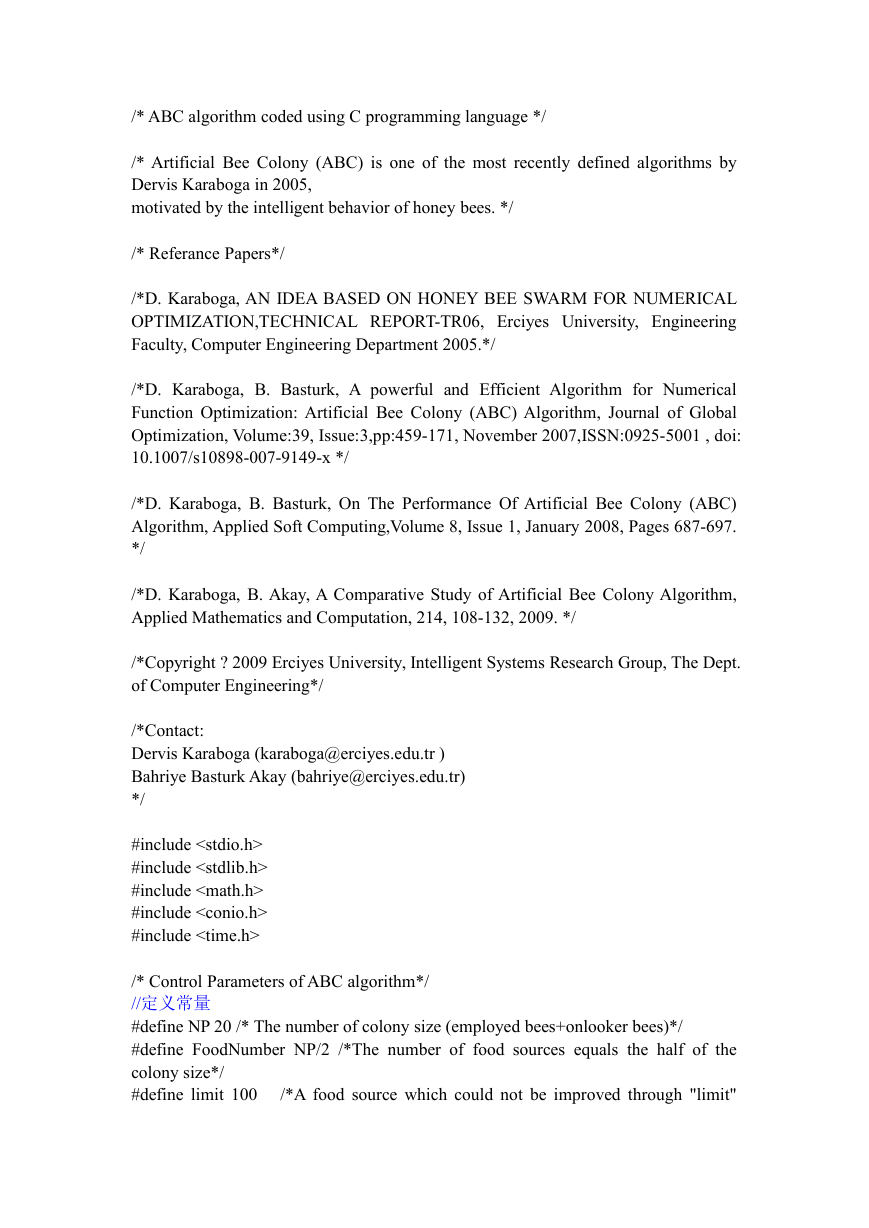
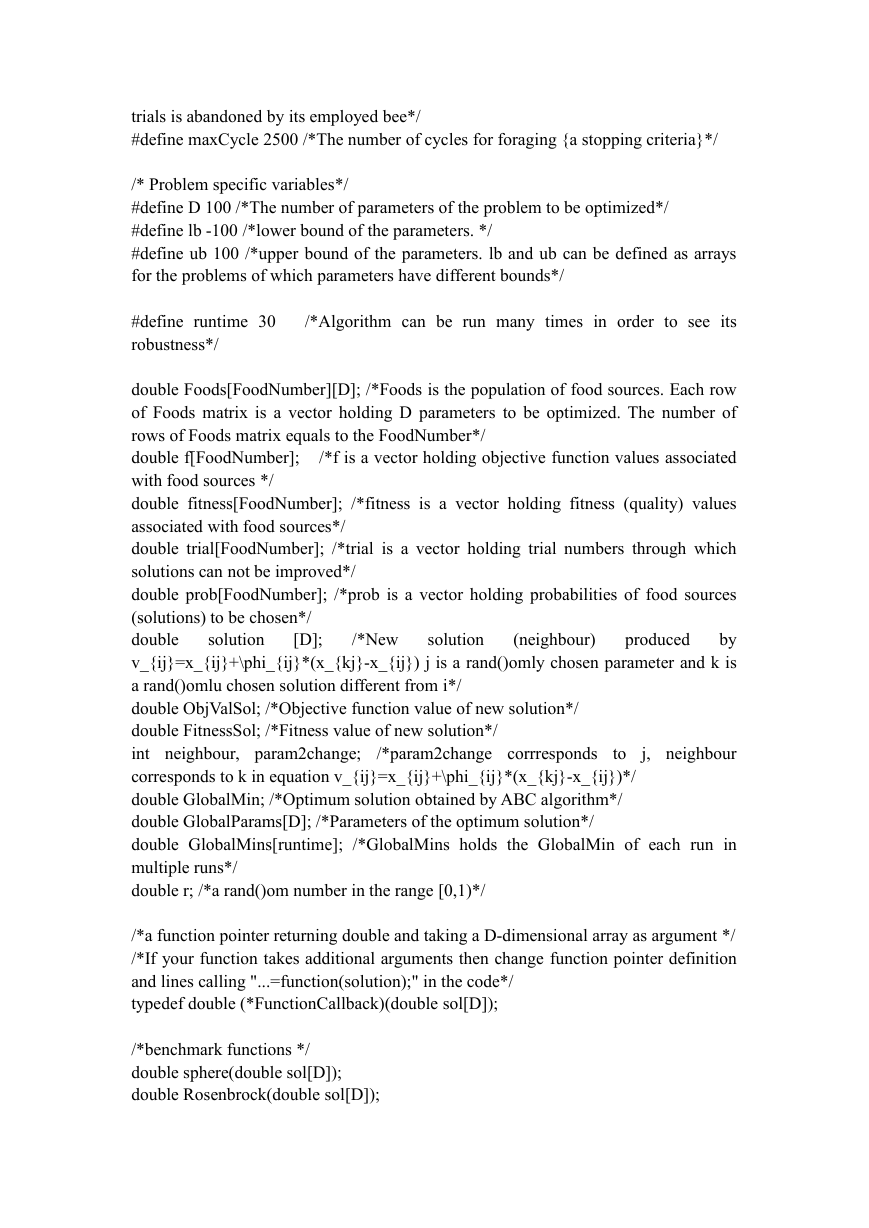



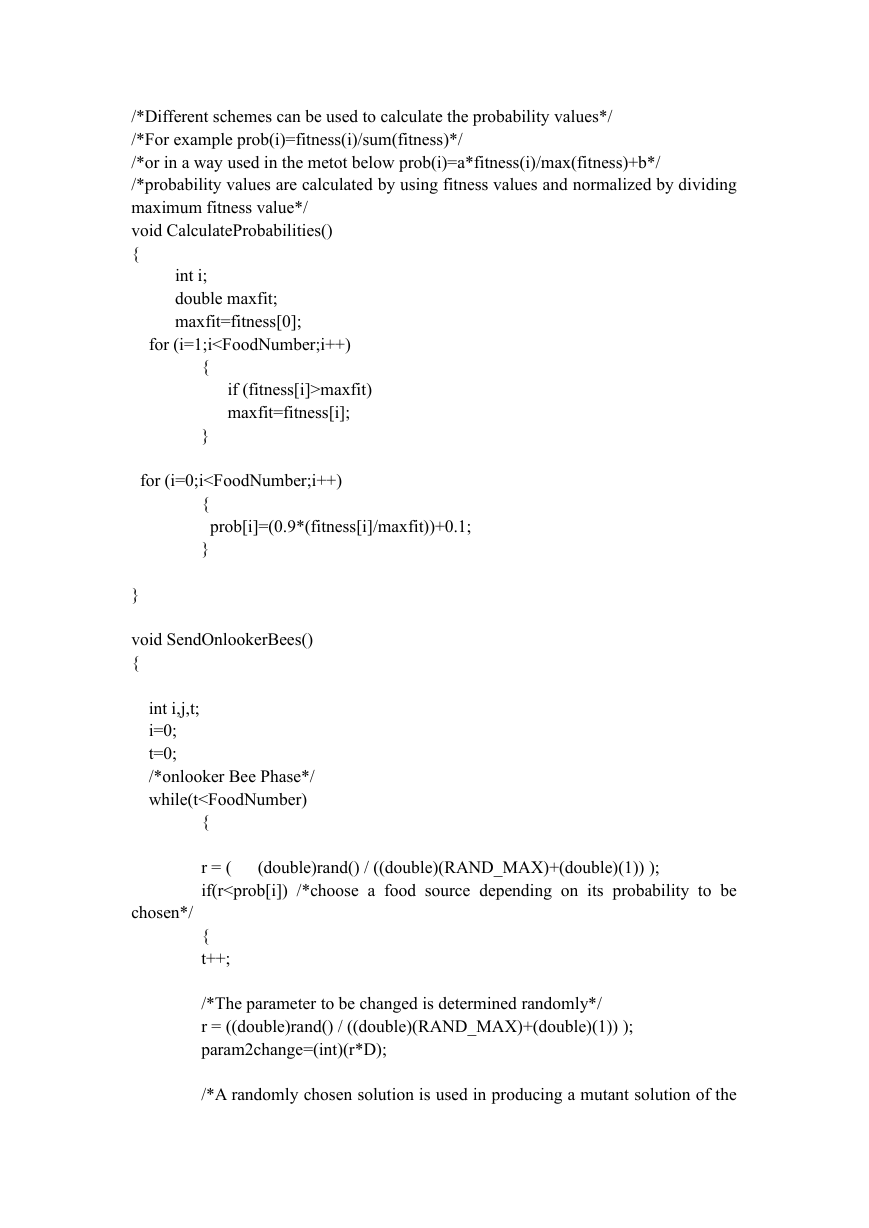
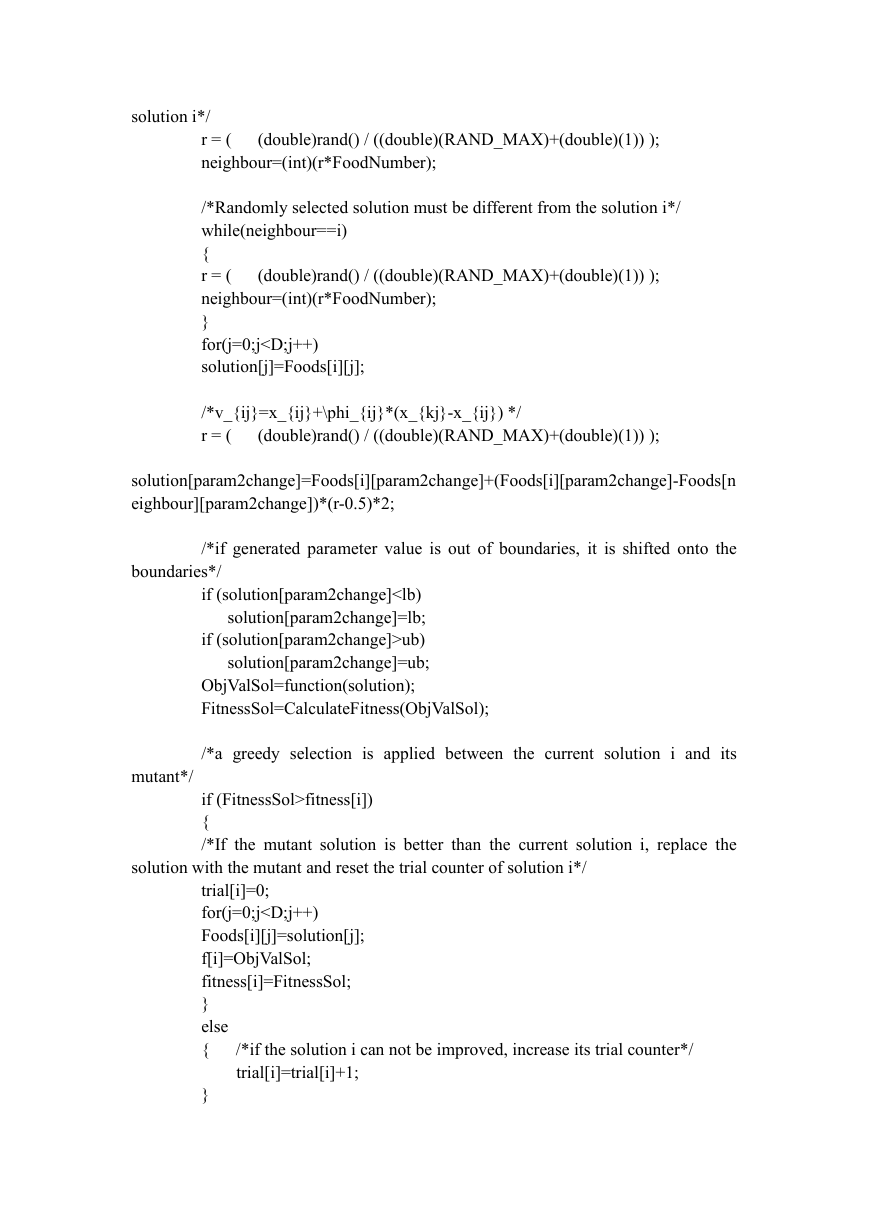
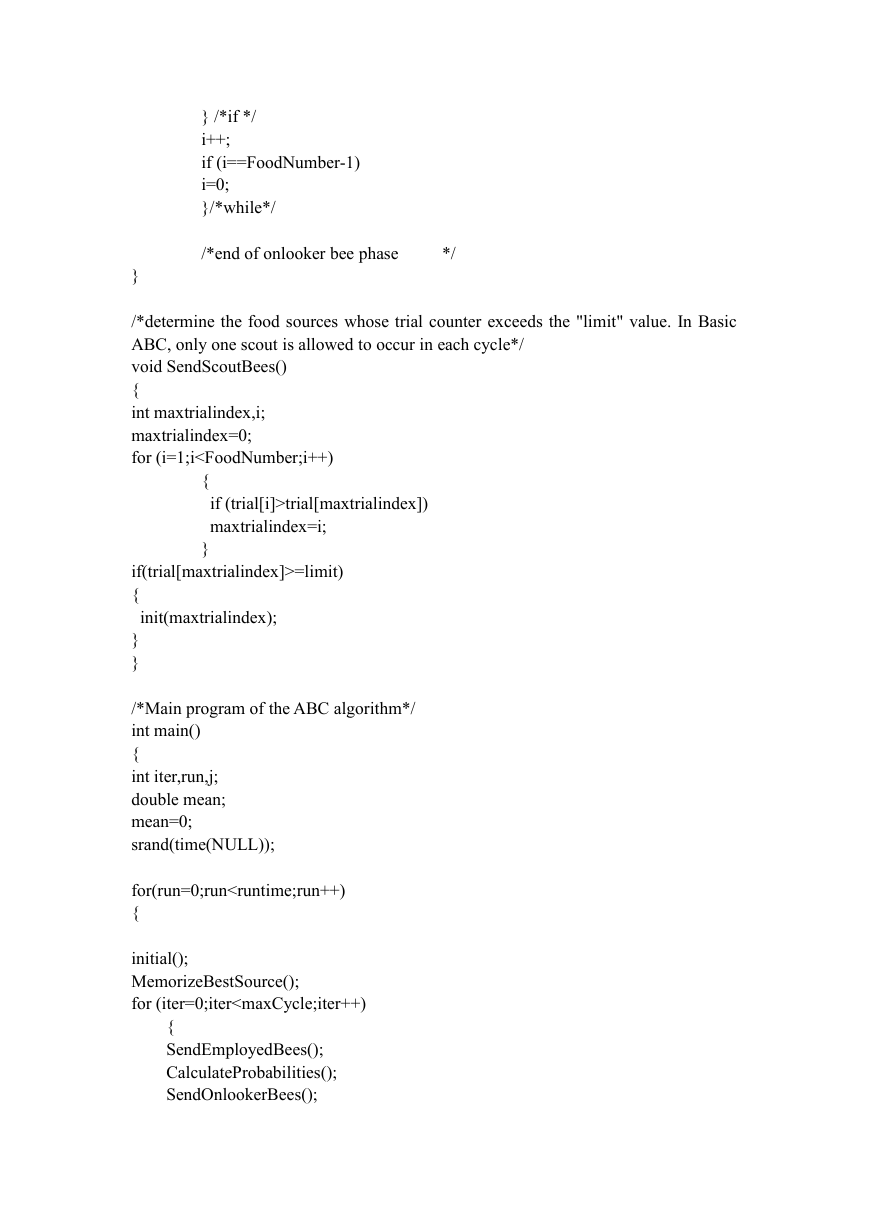








 2023年江西萍乡中考道德与法治真题及答案.doc
2023年江西萍乡中考道德与法治真题及答案.doc 2012年重庆南川中考生物真题及答案.doc
2012年重庆南川中考生物真题及答案.doc 2013年江西师范大学地理学综合及文艺理论基础考研真题.doc
2013年江西师范大学地理学综合及文艺理论基础考研真题.doc 2020年四川甘孜小升初语文真题及答案I卷.doc
2020年四川甘孜小升初语文真题及答案I卷.doc 2020年注册岩土工程师专业基础考试真题及答案.doc
2020年注册岩土工程师专业基础考试真题及答案.doc 2023-2024学年福建省厦门市九年级上学期数学月考试题及答案.doc
2023-2024学年福建省厦门市九年级上学期数学月考试题及答案.doc 2021-2022学年辽宁省沈阳市大东区九年级上学期语文期末试题及答案.doc
2021-2022学年辽宁省沈阳市大东区九年级上学期语文期末试题及答案.doc 2022-2023学年北京东城区初三第一学期物理期末试卷及答案.doc
2022-2023学年北京东城区初三第一学期物理期末试卷及答案.doc 2018上半年江西教师资格初中地理学科知识与教学能力真题及答案.doc
2018上半年江西教师资格初中地理学科知识与教学能力真题及答案.doc 2012年河北国家公务员申论考试真题及答案-省级.doc
2012年河北国家公务员申论考试真题及答案-省级.doc 2020-2021学年江苏省扬州市江都区邵樊片九年级上学期数学第一次质量检测试题及答案.doc
2020-2021学年江苏省扬州市江都区邵樊片九年级上学期数学第一次质量检测试题及答案.doc 2022下半年黑龙江教师资格证中学综合素质真题及答案.doc
2022下半年黑龙江教师资格证中学综合素质真题及答案.doc